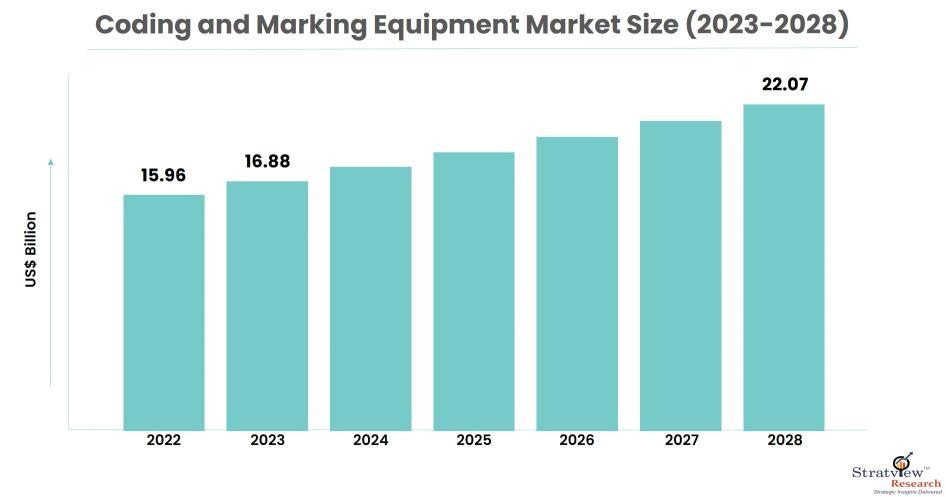The global coding and marking equipment market is an essential cog in the machinery of modern manufacturing and distribution. These seemingly simple systems, responsible for etching vital information onto products, play a critical role in ensuring product safety, traceability, and compliance with regulations. This article delves into the current state and projected future of this dynamic market, exploring its size, key players, dominant trends, and anticipated growth trajectory.
Market Size and Share: A Multi-Billion Dollar Industry
According to Stratview Research, the global coding and marking equipment market size was valued at USD 15.96 billion in 2022 and it is expected to grow at a CAGR of 5.50% during the forecast period of 2023-2028 to reach USD 22.07 billion by 2028. This figure reflects the widespread adoption of coding and marking technologies across diverse industries, including food and beverage, pharmaceuticals, electronics, and manufacturing. North America currently holds the largest market share. This dominance can be attributed to the well-established manufacturing sector and stringent regulations in this region. However, the Asia Pacific region is projected to witness the fastest growth in the coming years, driven by factors like rising disposable income, a burgeoning manufacturing base, and increasing government emphasis on product traceability.
Key Players and Competitive Landscape
The coding and marking equipment market is a competitive landscape with a mix of established players and emerging companies. Some of the leading players include:
- Domino Printing Science plc (UK)
- Videojet Technologies Inc. (US)
- Markem-Imaje (US)
- Xaar plc (UK)
- Eido Corporation (Japan)
Mergers and acquisitions are a recurring trend in this market, as companies strive to expand their product portfolios and geographical reach. Additionally, the rise of automation and Industry 4.0 principles is encouraging collaborations between coding and marking equipment manufacturers and automation solution providers.
Dominant Trends Shaping the Market
Several key trends are shaping the future of the global coding and marking equipment market:
- Advancements in Technology: Technological innovation is driving the development of faster, more precise, and cost-effective coding and marking solutions. Integration with Artificial Intelligence (AI) and the Industrial Internet of Things (IIoT) is paving the way for "smart" coding systems with features like predictive maintenance, self-optimizing printing parameters, and enhanced data collection for traceability.
- Sustainability Focus: Environmental consciousness is a growing concern for manufacturers. The market is witnessing a surge in eco-friendly solutions, including the use of biodegradable inks and solvents, low-energy consumption systems, and technologies minimizing ink and waste generation.
- Direct to Product (D2P) Coding: D2P technology eliminates the need for secondary packaging by directly marking codes onto the product itself. This trend offers advantages like reduced material usage, enhanced efficiency, and greater consumer engagement through capabilities like QR code printing for product information access.
- Customization on Demand: The market is responding to the growing demand for customized products with coding and marking solutions that facilitate on-the-fly code customization, variable data printing, and multi-color coding for enhanced functionalities and brand recognition.
Market Forecast: A Promising Future
The global coding and marking equipment market is expected to grow at a CAGR of 5.50% during the forecast period of 2023-2028 to reach USD 22.07 billion by 2028. The rise of e-commerce, increasing focus on brand protection against counterfeiting, and growing demand for personalized products are further factors expected to contribute to market expansion.
Regional Variations and Growth Potential
While the Asia Pacific region is anticipated to experience the fastest growth, each region presents unique opportunities:
- North America: Although market saturation exists, advancements in technology and increasing automation in manufacturing are expected to drive continued growth in this region.
- Europe: Stringent regulations and a well-established manufacturing sector will continue to propel market expansion in Europe.
- Emerging Markets: Latin America, Africa, and the Middle East offer significant growth potential due to rising investments in manufacturing infrastructure and growing awareness of product traceability.
